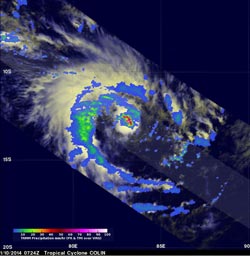NASA Adds Up Tropical Cyclone Colin's Rainfall Rates

NASA's TRMM satellite captured an image of rainfall occurring in Tropical Cyclone Colin on Jan. 13 at 0753 UTC. The bulk of Colin's rainfall was west and south of the center. <br>Image Credit: NASA/JAXA/SSAI, Hal Pierce<br>
The Tropical Rainfall Measuring Mission or TRMM satellite is managed by NASA and the Japan Aerospace Exploration Agency. TRMMM captured an image of rainfall rates occurring in Colin on Jan. 13 at 0753 UTC/2:53 a.m. EST.
TRMM Precipitation Radar showed that the bulk of Colin's rainfall was west and south of the center and there were some isolated areas where rain was falling at a rate of up to 2 inches/50 mm per hour.
Tropical Cyclone Colin is the eighth tropical cyclone in the Southern Indian Ocean cyclone season this year. It also has a separate designation from La Reunion Island, where it is known as “06/2013/2014.”
At 0900 UTC/4 a.m. EST on Jan. 13, Colin's maximum sustained winds were near 80 knots/148.2 kph/92.0 mph. Colin was located about 938 nautical miles/1,079 miles/1,737 km south of Diego Garcia, near 23.1 south and 75.0 east. Colin is moving to the south-southeast at 14 knots/16.1 mph/25.9 kph and over cooler sea surface temperatures that will cause it to weaken.
In addition to cooler sea surface temperatures, vertical wind shear is increasing as Colin tracks further south-southeast. Colin is expected to become extra-tropical in the next couple of days.
Text credit: Rob Gutro
NASA's Goddard Space Flight Center
Media Contact
All latest news from the category: Earth Sciences
Earth Sciences (also referred to as Geosciences), which deals with basic issues surrounding our planet, plays a vital role in the area of energy and raw materials supply.
Earth Sciences comprises subjects such as geology, geography, geological informatics, paleontology, mineralogy, petrography, crystallography, geophysics, geodesy, glaciology, cartography, photogrammetry, meteorology and seismology, early-warning systems, earthquake research and polar research.
Newest articles

Bringing bio-inspired robots to life
Nebraska researcher Eric Markvicka gets NSF CAREER Award to pursue manufacture of novel materials for soft robotics and stretchable electronics. Engineers are increasingly eager to develop robots that mimic the…

Bella moths use poison to attract mates
Scientists are closer to finding out how. Pyrrolizidine alkaloids are as bitter and toxic as they are hard to pronounce. They’re produced by several different types of plants and are…

AI tool creates ‘synthetic’ images of cells
…for enhanced microscopy analysis. Observing individual cells through microscopes can reveal a range of important cell biological phenomena that frequently play a role in human diseases, but the process of…





















